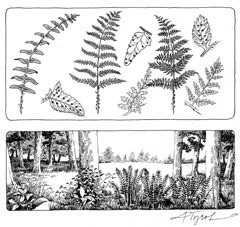
Ferns reward a close look. Their beauty is easy to appreciate from afar – the way a bed of ferns catches the sunlight filtering down among the trees, splashing bright green on the forest floor, enriching and somehow softening almost any woodsy glade.
But to truly appreciate them – to learn about them – you must stop and inspect one. Closely.
It’s only when you bend down, turn over a frond, and look carefully that they begin to give up their secrets.
In the language of botanists, ferns are non-flowering vascular plants. They reproduce by spores instead of by the more familiar flowers, pollen, and seeds.
They come to maturity in two distinct life cycles. The spores released by the fern fronds don’t grow into ferns; instead, they grow into small, heart-shaped plants called gametophytes. The gametophytes produce sperm and egg cells that, with the aid of water, will fuse and become a fern. Fern plants also can reproduce vegetatively – by sending up new fronds from spreading root-like rhizomes.
Quite often, the fern’s method of displaying its spores helps identify it. Some, like the ostrich fern (the familiar fiddlehead fern, edible before it uncurls) produce a plume-like stalk bearing the spores. The “plume” rises from the center of the ostrich fern and by autumn is dark brown and brittle. The spores themselves are invisible to the naked eye.
The ostrich fern most likely got its name because the “plume” reminded some early fancier of an actual ostrich plume.
Other ferns produce tiny dot-like sori on the underside of their fronds. These are sometimes called “fruit dots” and are, in effect, little cases holding the much tinier spores. They are green, or blackish, or tan, usually about the size of a pinhead, and may be round or crescent shaped, or linear, depending on the species of fern.
Their arrangement on the fern leaf also varies. In marginal woodfern, for example, the sori are aligned on the edges (the margins) of the fern’s pinnules or subleaflets. In northern lady fern the spores are in elongate or j-shaped sori near the middle of the underside of the pinnule.
That’s what I mean by close looking. You need to get right down on the forest floor with your woodfern, turn over the frond over to look for the “fruit dots” to identify it.
There are several other ways to determine the identity of a fern. Consider the shape and structure of the frond. Is it big or small? Coarse, with heavy leaflets, or delicate and lace-like? Is the overall shape of the frond a triangle? Or is it shaped like a pointed oval – a long, thin spearhead? Or something in between?
This all sounds confusing, but is easy to grasp visually; a half-hour in the woods with a fern expert or a good book and you’ll get it. So don’t give up. My favorite guide is “Common Ferns of Vermont,” written by Doug Westin, illustrated by Sue Westin, and published by the Vermont Department of Forests, Parks, and Recreation. It’s accurate throughout the Northern Forest ecosystem.
Ferns are amazing travelers; and here’s an amazing fact: Fern spores are so common, and so widely distributed by the wind, they are considered a common component of everyday atmospheric dust. They’re everywhere.
Not long ago, an Asian fern, Asplenium adiantum-nigrum, was discovered growing in the mountains of Colorado. It most likely hadn’t been transplanted. Its spores probably had blown in on the stratospheric winds from somewhere in Asia, and apparently landing on a bit of earth that it liked, it grew and established its own new outpost. We humans, notorious wanderers ourselves, found it there, classified it and wondered at it.
But that’s the way it is with ferns. Different species like to grow in different habitats. Goldie’s fern, narrow-leaved spleenwort, and the lovely, lacy maidenhair fern like limey soils. When you see them you can be sure there’s a limestone ledge or some other calcareous deposit under the soil.
Bracken fern likes acidic soils. Curling, dark-green polypody or rock fern likes to perch on shady rocks. And cinnamon fern and royal fern like marshy soils. If you see them, you can be pretty sure it will be boggy underfoot.
Thus each fern finds its own spot to prosper. Knowing that, and knowing that fern spores are as common as dust in the wind, you can imagine each species of fern, finding its own place and growing, fulfilling its own green and leafy destiny, raising its curled fronds gently in the sunlight in its own randomly selected place.

